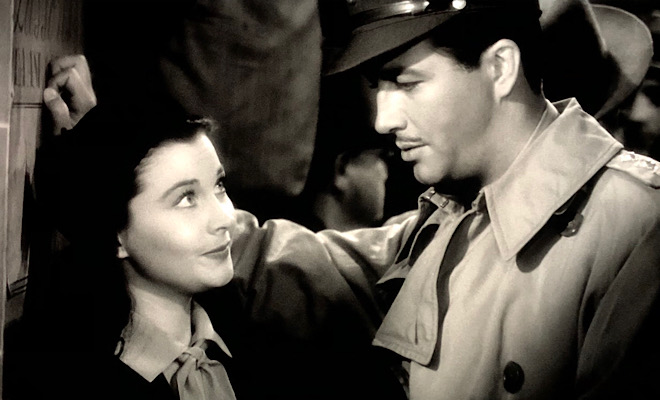
Waterloo Bridge (1940) opens with aged general Roy Cronin (Robert Taylor) leaving London to go to war in 1939. On his way to Waterloo Station he stops at Waterloo Bridge where he remembers Myra Lester (Vivien Leigh), his one true love whom he first me at that very spot during an air raid some twenty-three years earlier. The Roy Cronin of this framing device is a lonely, world weary man. He is the total opposite of what he was when he met and knew Myra Lester during WWI. And though Roy Cronin is essentially the storyteller, the film itself is more focused on Myra. As is the case with people in love, everything one remembers or thinks to say has to do with that one human being that matters more than all others.
The flashback, which is the bulk of Waterloo Bridge, is a classic example of the “fallen woman” narrative. Myra meets Roy while he’s on leave, they become engaged and within twenty-four hours he is shipped off to the front. Once his death is misreported Myra’s life comes undone and she eventually must resort to prostitution in order to survive. Then one day, while she’s cruising Waterloo Station, she happens upon Roy, fresh off the train. Myra tries to hide her profession from Roy but, after a trip to his family’s estate in Scotland, she cannot and abruptly leaves him. As Roy combs all of London with Myra’s friend Kitty (Virginia Field), Myra throws herself under an oncoming Red Cross ambulance and dies.
Mervyn LeRoy’s direction of Waterloo Bridge emphasizes the romantic qualities of the “fallen woman” narrative. The London of this film is moody, atmospheric and mysterious; gesturing towards the romance novels of the nineteenth century. In addition LeRoy uses a “wall to wall” musical score of traditional romantic pieces that evoke any number of emotional responses.
LeRoy’s direction of his actors, particularly Taylor (who is at his most emotive and charming here), reveals the filmmaker’s commitment to seeing the story as romantically tragic. There’s a moment early on where Roy goes to see Myra perform in the ballet in which Roy, sitting at least six rows back from the stage, fidgets and cranes his neck to keep his eyes on Myra when she dances into the wings. It is in little beats such as this from which Waterloo Bridge derives its emotional power.
Waterloo Bridge, based on a play by Robert E. Sherwood, isn’t concerned with being a moral lesson; this is a film dedicated to human emotional truth. When compared to Pabst’s Pandora’s Box (1929) the tragedy of Waterloo Bridge is not inevitable. The doom that awaits Lulu from the moment she comes on screen never becomes a part of Myra Lester until she’s face to face with the ambulance that kills her.
Unlike so many films in this vein the male lead does not chastise nor judge the fallen female protagonist. It is society that will scorn her, not her lover. LeRoy never delegates society’s voice to a single character either. The patriarchal machine that would see Myra’s downfall exists but it is only ever hinted at in casual dialogue; almost innuendo. In this way LeRoy pinpoints how this oppressive cultural force makes victims out of everyone of the main and supporting characters.
The concept of the society of the nineteen-teens as this elusive antagonist is what makes Waterloo Bridge something unique. Waterloo Bridge comes rather early in the cycle of wartime women’s pictures before the U.S. entered the war and a better antagonist or proxy could be found. The villain is the world we made and Waterloo Bridge, beneath all of the sentiment and romanticism, tries to reckon with that.
